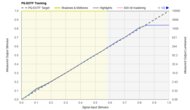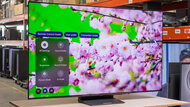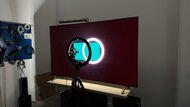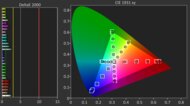A few great options are available if you're looking for the best gaming TV for PS5 or the best TV for PS5 Pro. When evaluating how good a TV is for PS5 gaming, certain criteria are most important. A TV's refresh rate is one of the most important factors, as it's inherently tied to the frame rate. If you want to game at 120 fps, you need a TV that supports a 120Hz refresh rate. A high refresh rate also goes hand-in-hand with VRR, as VRR lets the TV dynamically adjust its refresh rate to match the game's frame rate, minimizing, if not eliminating, any screen tearing that can result from the game's frame rate not matching the TV's refresh rate.
Response time is the time it takes for a pixel to change from one color to the next. TVs with a slow response time leave blurry trails behind fast motion, while TVs with fast response times deliver clear motion. OLEDs are the uncontested best TVs regarding response time, as their pixel transitions are nearly instantaneous. Input lag is the time it takes for your controller inputs to register on screen. Through our rigorous testing process, we've discovered that most TVs nowadays have low enough input lag that you don't feel a delay between your inputs and the action on screen, but if you're mainly a competitive gamer, you will want the lowest input lag possible.
A TV's overall image quality is also very important for gaming, especially if you own a PS5 Pro and want to fully appreciate the graphical improvements it offers. If you game in a bright room, you need a TV that's bright enough to fight glare so you aren't distracted by reflections on your screen. You also want a TV that displays a wide range of colors and has sufficient contrast to highlight objects against dark backgrounds in HDR. We determine whether a TV's picture quality deteriorates while using Game Mode and which TVs simultaneously offer excellent performance and image quality.
Below are our recommendations for the best gaming televisions for PS5 and PS5 Pro, depending on your budget and needs. Also, see our picks for the best gaming TVs, the best 8k TVs, and the best TVs for Switch 2. You can also vote on which ones you want us to buy and test. To learn more about the 2025 models, check out our 2025 TV lineup page.

We buy and test dozens of TVs yearly, taking an objective, data-driven approach to deliver results you can trust. Our testing process is complex, with hundreds of individual tests that take over a week to complete. Most of our tests are done with specially designed test patterns that mimic real content, but we also use the same sources you have at home to ensure our results match the real-world experience. We use two main tools for our testing: a Colorimetry Research CR-100 colorimeter and a CR-250 spectroradiometer.
-
Best TV For PS5
 Mixed Usage8.9Home Theater9.0Bright Room8.8Sports8.8Gaming9.3Brightness8.7Black Level10Color9.1Processing (In Development)8.3Game Mode Responsiveness9.4Motion Handling (Broken)7.7Resolution:4kNative Refresh Rate:165HzScreen Finish:MatteType:OLEDSub-Type:QD-OLEDDolby Vision:NoSee all our test resultsSizes:55" 65" 77" 83"
Mixed Usage8.9Home Theater9.0Bright Room8.8Sports8.8Gaming9.3Brightness8.7Black Level10Color9.1Processing (In Development)8.3Game Mode Responsiveness9.4Motion Handling (Broken)7.7Resolution:4kNative Refresh Rate:165HzScreen Finish:MatteType:OLEDSub-Type:QD-OLEDDolby Vision:NoSee all our test resultsSizes:55" 65" 77" 83"The best TV for PS5 that we've tested is the Samsung S95F OLED. It's an exceptional TV that delivers an incredible gaming experience. Motion in fast-paced action games looks sharp and clear thanks to the nearly instantaneous response time. Gaming feels very responsive thanks to the TV's low input lag, and its VRR support provides a nearly tear-free gaming experience. Since this TV utilizes a QD-OLED panel, colors are bright and vivid, so the games in your collection really stand out on the screen. It features four HDMI 2.1 bandwidth ports, capable of supporting up to 4k @ 165Hz, allowing the TV to take full advantage of everything the PS5 and the PS5 Pro offer, including 4k @ 120Hz gaming in compatible games. These ports are located on the external Slim One Connect Box, which provides a versatile way to connect all your devices.
Being an OLED, the TV's near-infinite contrast ratio and perfect black levels mean that it will perfectly display the detailed shadows and nuanced reflections that the PS5 Pro offers with its advanced ray-tracing capabilities. Like any OLED, it looks its best in a dark room. However, this TV's matte coating and high peak brightness enable it to easily overcome glare in very bright rooms, so you don't have to deal with annoying reflections on your screen. If you need a TV for your current PS5 or your new PS5 Pro that does it all, the S95F is an amazing option.
-
Best 8k TV For PS5 Pro
 Mixed Usage8.0Home Theater8.1Bright Room8.0Sports8.0Gaming7.7Brightness8.4Black Level8.3Color8.0Processing (In Development)7.9Game Mode Responsiveness7.4Motion Handling (Broken)7.8Resolution:8kNative Refresh Rate:60HzScreen Finish:GlossyType:LEDSub-Type:VADolby Vision:NoSee all our test resultsSizes:65" 75" 85"
Mixed Usage8.0Home Theater8.1Bright Room8.0Sports8.0Gaming7.7Brightness8.4Black Level8.3Color8.0Processing (In Development)7.9Game Mode Responsiveness7.4Motion Handling (Broken)7.8Resolution:8kNative Refresh Rate:60HzScreen Finish:GlossyType:LEDSub-Type:VADolby Vision:NoSee all our test resultsSizes:65" 75" 85"With the PS5 Pro's 8k capabilities, you might be considering a new TV to play Gran Turismo 7 in 8k or to take advantage of the new AI upscaling the console offers. There are not many 8k models on the market, but there is the high-end Samsung QN900D 8k QLED. Luckily, it has outstanding picture quality overall, making it the best TV for PS5 Pro for those who want 8k. Its contrast ratio is one of the highest on the market when it comes to LED models, thanks to its highly effective local dimming solution, so it delivers very deep blacks with minimal blooming. It's also very bright overall, so it easily overcomes glare in a well-lit room and highlights really stand out in HDR games. Colors are also bright and vibrant on this TV, which is great for games with a vivid color palette.
The TV's four HDMI 2.1 ports support up to 8k @ 60Hz, but they also support a whopping 4k @ 240Hz. Neither the PS5 nor the PS5 Pro can run games above 120 fps, but if you also own a powerful gaming PC, you might be able to put that incredibly high refresh rate to good use. The TV also supports VRR, has low input lag, and a decent response time. You could also get the Samsung QN990F 8k if you want a very similar TV, but with a matte coating. However, it's a lot more expensive than the 2024 model, so most people are better off getting the QN990D while it's at its most affordable. Still, you can get a nearly instantaneous response time, lower input lag, deeper blacks, and more vibrant colors from any OLED on our list. Those factors are more important for picture quality than pure resolution, so unless you really want to play the small number of games that actually support 8k on the PS5 Pro, your money is better spent on a high-end 4k model like the Samsung S95F OLED.
-
Best Upper Mid-Range TV For PS5
 Mixed Usage8.6Home Theater8.8Bright Room7.6Sports8.1Gaming9.1Brightness8.0Black Level10Color8.8Processing (In Development)8.4Game Mode Responsiveness9.4Motion Handling (Broken)7.9Resolution:4kNative Refresh Rate:144HzScreen Finish:GlossyType:OLEDSub-Type:QD-OLEDDolby Vision:NoSee all our test resultsSizes:42" 48" 55" 65" 77" 83"
Mixed Usage8.6Home Theater8.8Bright Room7.6Sports8.1Gaming9.1Brightness8.0Black Level10Color8.8Processing (In Development)8.4Game Mode Responsiveness9.4Motion Handling (Broken)7.9Resolution:4kNative Refresh Rate:144HzScreen Finish:GlossyType:OLEDSub-Type:QD-OLEDDolby Vision:NoSee all our test resultsSizes:42" 48" 55" 65" 77" 83"If the Samsung S95F OLED sounds like the TV for you, but its high price tag is out of reach, you can step down to the Samsung S90F OLED without sacrificing very much. Unlike the S95F, it features a more traditional glossy screen coating that doesn't handle reflections as well, although it still does an admirable job of reducing their intensity. However, the TV isn't nearly as bright in SDR, so it's better suited for moderately lit rooms. Still, you get the same perfect black levels, incredibly punchy colors, and impressive HDR brightness. SDR games look amazing, and the TV truly shines when displaying HDR games, so you get impressive image quality from every game in your collection.
This model doesn't have 165Hz like the more expensive Samsung does, but it still caps out at an impressive 4k @ 144Hz, so it easily takes care of the 120Hz maximum that the PS5 and PS5 Pro offer. You also still get VRR support for almost no screen tearing, low input lag for a snappy feel, and nearly instantaneous pixel transitions that deliver clear motion. Despite being in our upper mid-range category, this model is still one of the best TVs for PS5 and PS5 Pro on the market. Just be aware that only the 55, 65, and 77-inch models use a QD-OLED panel, and this also depends on your region.
-
Best Mid-Range TV For PS5
 Mixed Usage8.2Home Theater8.4Bright Room6.7Sports7.1Gaming8.5Brightness7.0Black Level10Color8.3Processing (In Development)8.3Game Mode Responsiveness9.0Motion Handling (Broken)7.6Resolution:4kNative Refresh Rate:120HzScreen Finish:GlossyType:OLEDSub-Type:WOLEDDolby Vision:YesSee all our test resultsSizes:48" 55" 65" 77" 83"
Mixed Usage8.2Home Theater8.4Bright Room6.7Sports7.1Gaming8.5Brightness7.0Black Level10Color8.3Processing (In Development)8.3Game Mode Responsiveness9.0Motion Handling (Broken)7.6Resolution:4kNative Refresh Rate:120HzScreen Finish:GlossyType:OLEDSub-Type:WOLEDDolby Vision:YesSee all our test resultsSizes:48" 55" 65" 77" 83"The LG B5 OLED is the best 4k TV for PS5 in the mid-range category. It's one of the most affordable OLEDs on the market, with only a few drawbacks compared to the more expensive QD-OLEDs from Samsung. It delivers great picture quality, with its near-infinite contrast ratio producing inky blacks alongside bright highlights, which is ideal for the ray-tracing upgrades that the PS5 Pro offers. Colors don't pop as much as they do on the S95F and S90F, but they're still punchy enough to please most gamers. It's not as bright either, but highlights still pop out well in HDR games, and it gets just bright enough to handle glare in a room with some overhead lights on. However, reflections are visible on the screen in bright rooms.
The TV has four HDMI 2.1 ports that offer 4k @ 120Hz with VRR, so it takes full advantage of the features offered by the PS5 and PS5 Pro. It also delivers crystal clear motion thanks to the TV's nearly instantaneous pixel response times, and gaming feels snappy due to its low input lag. Although it doesn't offer quite the same level of image quality as the Samsung options above, this TV is a great entry point into the OLED market. If you're solely using it with your PS5 or PS5 Pro, you don't really miss out on any gaming features by choosing it over the more expensive Samsung models, so you can save some money and put it towards the PS5 Pro.
-
Best Lower Mid-Range TV For PS5
 Mixed Usage7.8Home Theater7.9Bright Room8.0Sports7.9Gaming7.8Brightness7.8Black Level8.4Color7.5Processing (In Development)7.7Game Mode Responsiveness8.0Motion Handling (Broken)7.5Resolution:4kNative Refresh Rate:144HzScreen Finish:GlossyType:LEDSub-Type:VADolby Vision:YesSee all our test resultsSizes:55" 65" 75" 85" 98"
Mixed Usage7.8Home Theater7.9Bright Room8.0Sports7.9Gaming7.8Brightness7.8Black Level8.4Color7.5Processing (In Development)7.7Game Mode Responsiveness8.0Motion Handling (Broken)7.5Resolution:4kNative Refresh Rate:144HzScreen Finish:GlossyType:LEDSub-Type:VADolby Vision:YesSee all our test resultsSizes:55" 65" 75" 85" 98"If you're tight on money but still want a TV that is packed with modern gaming features, the TCL QM7K is the best PS5 TV in the lower mid-range category. It has two HDMI 2.1 ports that offer up to 4k @ 144Hz with VRR, making it fully compatible with both PlayStation consoles. It even offers 1080p @ 288Hz for those who also have a gaming PC. The TV's input lag is very low, but it doesn't have the same level of motion handling as our OLED picks. However, pixel transitions are quick for an LED TV, so fast motion only has minimal blur behind it.
You don't get the same perfect black levels that OLED TVs provide, but since this model has great local dimming, blacks are still deep and bold, albeit with some haloing around highlights and text. Fortunately, this is a very bright TV, so it easily handles glare from overhead lights and other indirect sources of light. However, any direct reflections, like a lamp opposite your screen, are visible and distracting. HDR games look very good on this TV, with bright highlights and vibrant colors that make games pop. As great as this TV is for the PS5, you'll likely want one of our higher picks if you want to see the full potential of the PS5 Pro's graphics displayed on your screen.
-
Best Budget TV For PS5
 Mixed Usage7.1Home Theater7.2Bright Room7.0Sports7.1Gaming7.2Brightness6.5Black Level7.6Color7.2Processing (In Development)7.0Game Mode Responsiveness7.9Motion Handling (Broken)7.6Resolution:4kNative Refresh Rate:144HzScreen Finish:GlossyType:LEDSub-Type:VADolby Vision:YesSee all our test resultsSizes:55" 65" 75" 85" 98"
Mixed Usage7.1Home Theater7.2Bright Room7.0Sports7.1Gaming7.2Brightness6.5Black Level7.6Color7.2Processing (In Development)7.0Game Mode Responsiveness7.9Motion Handling (Broken)7.6Resolution:4kNative Refresh Rate:144HzScreen Finish:GlossyType:LEDSub-Type:VADolby Vision:YesSee all our test resultsSizes:55" 65" 75" 85" 98"If the gaming features found on the TCL QM7K are enticing, but the TV is a bit too expensive, consider stepping down to the TCL QM6K. The TV's gaming performance is nearly on par with that of the more expensive TCL model and features the same set of capabilities. It has HDMI 2.1 bandwidth on two ports for up to 4k @ 144Hz gaming with a full VRR range, so it takes care of the maximum 120Hz refresh rate the PS5 and PS5 Pro offer. Input lag is just as low, pixel transitions are almost as fast, and it even supports 1080p @ 288Hz for those who also have powerful gaming PCs.
Although this model is comparable to the QM7K in terms of gaming features, it falls short in image quality, yet it remains quite good overall. It features local dimming to create deep blacks, which is impressive for a budget model. Colors are more muted than on the QM7K, but they're still vibrant enough to avoid looking lifeless. The TV's SDR brightness is sufficient, allowing it to overcome glare from indirect light sources. Unfortunately, the TV's HDR is too dim for highlights to truly pop, which makes HDR games look somewhat lackluster. Still, this TV is a solid option for those on a budget who still want modern gaming features.
-
Best Cheap TV For PS5
 Mixed Usage6.0Home Theater5.8Bright Room6.3Sports6.0Gaming6.2Brightness5.6Black Level4.9Color6.8Processing (In Development)6.3Game Mode Responsiveness6.7Motion Handling (Broken)7.0Resolution:4kNative Refresh Rate:60HzScreen Finish:GlossyType:LEDSub-Type:VADolby Vision:YesSee all our test resultsSizes:43" 50" 55" 65" 75" 85" 100"
Mixed Usage6.0Home Theater5.8Bright Room6.3Sports6.0Gaming6.2Brightness5.6Black Level4.9Color6.8Processing (In Development)6.3Game Mode Responsiveness6.7Motion Handling (Broken)7.0Resolution:4kNative Refresh Rate:60HzScreen Finish:GlossyType:LEDSub-Type:VADolby Vision:YesSee all our test resultsSizes:43" 50" 55" 65" 75" 85" 100"If you're a price-conscious PS5 gamer and the TCL QM6K is a bit too pricey for you, yet you still want a great experience, the best budget TV for PlayStation 5 that you can get is the Hisense QD6QF. This model lacks local dimming, so blacks appear flat and lack depth in most games. It's not the brightest TV either, so HDR games look a bit flat. The TV is just bright enough to handle some glare in a room with a couple of overhead lights on, but direct reflections are very visible, and it's too dim for bright rooms. Colors are a bit muted on this model, but it does support a wide range of colors, so the image doesn't look too dull.
The TV doesn't have HDMI 2.1 bandwidth, so 4k @ 120Hz is a no-go, but you can still game in either 4k @ 60Hz or 1440p @ 120Hz. However, input lag is very high in 1440p @ 120Hz, which holds back its usefulness. Fortunately, you can still game in 4k @ 60Hz with decently low input lag. Pixel response times are on the slower side, but there's significantly less motion blur compared to many other cheap models, and you still benefit from VRR to reduce screen tearing.
Notable Mentions
-
LG G5 OLED:
The LG G5 OLED is an outstanding TV overall and goes head-to-head with the Samsung S95F OLED. The LG's colors are very impressive, but the Samsung's QD-OLED colors still look a bit more vibrant. The LG gets a little brighter, but the Samsung does a better job dealing with glare, which makes it a better pick for most gamers overall.
See our review -
LG C5 OLED:
The LG C5 OLED is a solid alternative to the Samsung S90F OLED. It's brighter when watching SDR content, shows deeper blacks in dark rooms, and supports Dolby Vision. That said, the Samsung has more vivid colors and gets brighter in its dedicated gaming mode, making it the better choice for most gamers.
See our review -
TCL QM8K:
The TCL QM8K is a great alternative to the LG B5 OLED if you mostly use your PS5 in a bright room, as it's significantly brighter than the LG. You don't get the same crystal clear motion as you do on the LG, but it's pretty good for an LED TV, so motion isn't too blurry. It also doesn't display the same inky blacks as the LG, but blacks are still quite deep.
See our review -
Hisense U75QG:
The Hisense U75QG is a brighter pick than the TCL QM7K, but it has a few issues. It really overbrightens HDR content, so HDR games don't look the way they're supposed to. Plus, its slower pixel transitions make fast motion look blurry. Since the TCL has clearer motion and much better black levels, it's the better choice for most PlayStation gamers.
See our review -
Hisense U65QF:
The Hisense U65QF is brighter than the TCL QM6K, but it makes HDR games look much brighter than intended. The TCL has better color accuracy, deeper blacks, and lower input lag, making it the better choice for most gamers.
See our review -
Hisense QD6QF:
The TCL S551G is an alternative to the Hisense QD6QF. The Hisense offers superior image quality, making it the better option for most people. However, the 120Hz mode that the TCL offers has significantly lower input lag than the Hisense, making it a good option for PS5 gamers on a budget who prefer performance over image quality.
See our review
Recent Updates
Nov 10, 2025:
We replaced the LG B4 OLED with the LG B5 OLED in the 'Best Mid-Range' category, and replaced the TCL Q651G with the Hisense QD6QF in the 'Best Cheap' category. We also updated the Notable Mentions section.
Jul 17, 2025:
We replaced the Samsung S90D OLED with the Samsung S95F OLED as our new top pick. We also replaced the LG C4 OLED with the Samsung S90F OLED in the 'Upper Mid-Range' category, the Hisense U7N with the TCL QM7K in the 'Lower Mid-Range' category, the TCL QM651G with the TCL QM6K in the 'Budget' category, and the Hisense A7N with the TCL Q651G in the 'Best Cheap TV' category. We also dropped the 'Best Bright Room' category, since the S95F outperforms our old pick, the Sony BRAVIA 9.
Apr 17, 2025:
Updated some text throughout the article for clarity. We also removed the TCL QM7/QM751G QLED and the Hisense U6/U6N from the Notable Mentions section and added mention of the TVs in their comparable picks instead.
Dec 09, 2024:
Tweaked text throughout the article for clarity.
Sep 19, 2024: Replaced the Samsung S90C OLED, LG C3 OLED, LG B3 OLED, and TCL Q5/Q550G QLED with their 2024 successors. We also added the Samsung QN900D 8k QLED into a new 'Best 8k TV for PS5 Pro' category, updated the Notable Mentions, and refreshed text throughout the article to touch on the PS5 Pro.
All Reviews
Our recommendations are based on what we think are the best TVs for gaming on the PS5 and the best PS5 Pro TVs currently available. They're adapted to be valid for most people in each price range. Rating is based on our review, factoring in price and feedback from our visitors.
If you would prefer to make your own decision, here is the list of all of our TV reviews. Be careful not to get too caught up in the details. Most TVs are good enough to please most people, and the things we fault TVs on are often not noticeable unless you really look for them. Also, keep in mind that our scores aren't comparable across different test benches, so most of the older TVs in the list below score higher than they would in 2025.




























